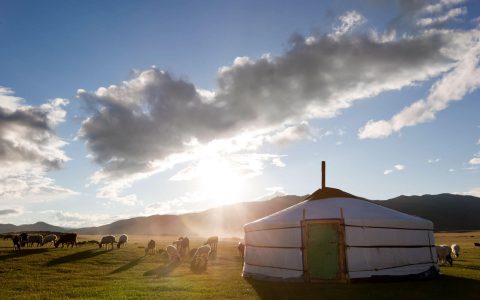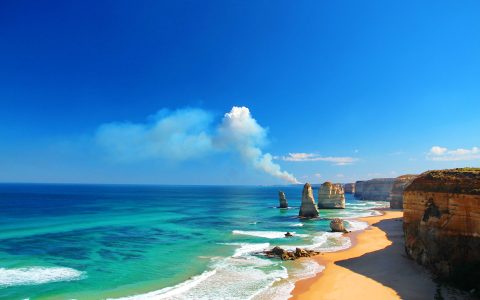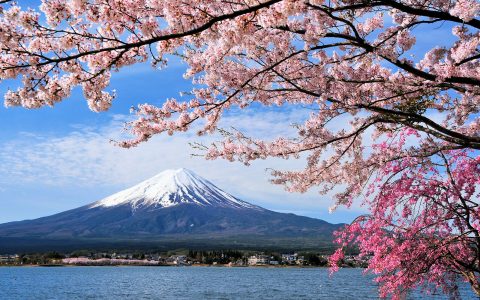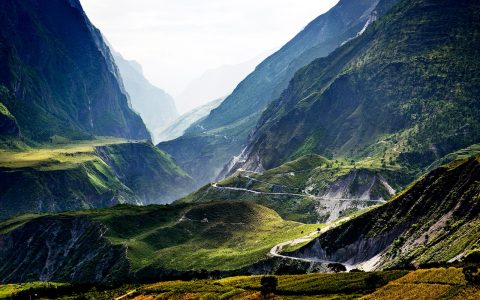Bhutan, Land of the Thunder Dragon
 If you are fortunate enough to make your way to Bhutan, a largely Buddhist country (although some Hinduism is practiced), it’s worth getting to know the spiritual traditions of this deeply devout people. Known for its reliance on measuring Gross National Happiness over all else, Bhutan is also called the land of the Thunder Dragon, a reference to its wild thunderstorms striking the valleys from the peaks of the Himalayas. The dazzling light of thunder was believed to be the fire from a dragon. Learn about Bhutanese culture through its main religion, Buddhism, and its main beliefs.
If you are fortunate enough to make your way to Bhutan, a largely Buddhist country (although some Hinduism is practiced), it’s worth getting to know the spiritual traditions of this deeply devout people. Known for its reliance on measuring Gross National Happiness over all else, Bhutan is also called the land of the Thunder Dragon, a reference to its wild thunderstorms striking the valleys from the peaks of the Himalayas. The dazzling light of thunder was believed to be the fire from a dragon. Learn about Bhutanese culture through its main religion, Buddhism, and its main beliefs.
Symbolism in a Flag
 The upper half of the national flag is yellow, signifying action and the secular authority of the king. The lower half is orange to represent the spiritual power of Buddhism.
The upper half of the national flag is yellow, signifying action and the secular authority of the king. The lower half is orange to represent the spiritual power of Buddhism.
The druk (white dragon) honours the thunder dragon, after which the country is named; white also symbolizes purity. The dragon clutches jewels in his claws as a symbol of the country’s wealth.
Bhutan’s National Anthem
In the Thunder Dragon Kingdom adorned with sandalwood,
The protector who guards the teachings of the dual system,
He, the precious and glorious ruler, causes dominion to spread,
While his unchanging person abides in consistency,
As the doctrine of the Lord Buddha flourishes,
May the sun and peace of happiness shine on the people.
The Origins of Buddhism
 The origins of Buddhism come from India: the prince Siddhartha Gautama was born into a privileged and sheltered existence. It was immediately apparent to some that Prince Siddhartha was more than just a prince, but his parents did not want him to discover this, so he was kept in isolation.
The origins of Buddhism come from India: the prince Siddhartha Gautama was born into a privileged and sheltered existence. It was immediately apparent to some that Prince Siddhartha was more than just a prince, but his parents did not want him to discover this, so he was kept in isolation.
A sage predicted that the prince would either become a powerful king or, if he embraced religious life, a great spiritual leader. When he was finally exposed to the pain and suffering of the outside world, he decided to become an ascetic and wandered the world in an attempt to find a way to end all suffering. He finally reached enlightenment and became the Buddha while meditating under a banyan tree.
His dharma, or teachings, includes the Four Noble Truths and the Eight-Fold Path to Enlightenment. The long-standing debate on Buddhism concerns whether it is, technically, a religion. The answer lies in the definition of religion, since Buddhism shares many characteristics with traditional religions, but it neither acknowledges nor denies the existence of a god.
 In Bhutan (as well as in Tibet, Nepal, and the Himalayan regions of India), the ‘second buddha’ many people revere is Padmasambhava (meaning ‘lotus-born’; he was reported to have been discovered as a child floating in a lotus blossom), an 8th-century Indian Buddhist master who is credited for bringing the religion to Tibet and the region. Legend has it that he flew to what is now Paro Taktsang (the Tiger’s Nest monastery) in Bhutan on the back of a flying tiger, and meditated in a cave, which you can see today.
In Bhutan (as well as in Tibet, Nepal, and the Himalayan regions of India), the ‘second buddha’ many people revere is Padmasambhava (meaning ‘lotus-born’; he was reported to have been discovered as a child floating in a lotus blossom), an 8th-century Indian Buddhist master who is credited for bringing the religion to Tibet and the region. Legend has it that he flew to what is now Paro Taktsang (the Tiger’s Nest monastery) in Bhutan on the back of a flying tiger, and meditated in a cave, which you can see today.
Buddhists believe in the following truths, and pathways to enlightenment:
The Four Noble Truths
- The world is full of suffering.
- Suffering is caused by desire.
- Suffering can be overcome.
- Suffering is overcome via the eightfold path.
The Noble Eightfold Path to Enlightenment
 To reach a state in which there is no suffering, one must follow a path. The stages of this path are as follows:
To reach a state in which there is no suffering, one must follow a path. The stages of this path are as follows:
- Right View
- Right Thought
- Right Speech
- Right Behaviour
- Right Livelihood
- Right Effort
- Right Mindfulness
- Right Concentration
Experience Bhutan With B&R
Private Bhutan Hiking
We’re lucky enough to be among the 14,000 visitors granted permission to enter Bhutan each year—and we’re happy to share our good fortune with you. On our Bhutan Hiking, life-altering moments and Gross National Happiness await at every turn.
DETAILED ITINERARYPrivate Bhutan Cultural Journey
The vivid richness of Bhutanese culture, from daily Buddhist rituals to centuries-old temples, is one to witness firsthand. On our Bhutan Cultural Journey, marvel at the astonishing Tiger’s Nest monastery and other wonders in the Land of the Thunder Dragon.
DETAILED ITINERARY
Theravada Buddhism
Also known as Hinayana, the “doctrine of the elders,” Theravada Buddhism is practiced in Thailand, Sri Lanka and Burma. This school professes that the path to nirvana (or enlightenment—the aim of all Buddhists) is an individual one. The worship of deities is considered to be secondary. Individuals work toward breaking the cycle of rebirth by following the teachings of Buddha.
Mahayana Buddhism
 In Mahayana, “the great vehicle,” the belief is that one seeks nirvana, not for personal gain, but to help others. The most important virtues are compassion (coupled with a genuine desire to alleviate suffering) and wisdom. The Buddha is seen as a supramundane principle and has many different realms. There is also a pantheon of cosmic and celestial buddhas and bodhisattvas. A bodhisattva is an enlightened being who delays entry into nirvana to help others on the path to enlightenment.
In Mahayana, “the great vehicle,” the belief is that one seeks nirvana, not for personal gain, but to help others. The most important virtues are compassion (coupled with a genuine desire to alleviate suffering) and wisdom. The Buddha is seen as a supramundane principle and has many different realms. There is also a pantheon of cosmic and celestial buddhas and bodhisattvas. A bodhisattva is an enlightened being who delays entry into nirvana to help others on the path to enlightenment.

Tantric or Vajrayana Buddhism
 This emerged in India as a further evolution of Mahayana Buddhism during the second to fourth centuries. In Vajrayana (which means “thunderbolt vehicle”), there is a Tantric, or dual energy, a manifestation also found in many elements of Hinduism. It espouses that one must learn to transcend opposites and view them as dual manifestations of consciousness. It also teaches the harnessing and channelling of different energies in the body. The aim of Tantric practice is to transform one’s mind, body and speech to reach the state of a fully enlightened being by special yogic means. This includes a variety of esoteric and ritual methods only available to the initiated. Today, Tantric Buddhism is found only in Tibet, Ladakh, Mongolia, Nepal, Bhutan and Japan.
This emerged in India as a further evolution of Mahayana Buddhism during the second to fourth centuries. In Vajrayana (which means “thunderbolt vehicle”), there is a Tantric, or dual energy, a manifestation also found in many elements of Hinduism. It espouses that one must learn to transcend opposites and view them as dual manifestations of consciousness. It also teaches the harnessing and channelling of different energies in the body. The aim of Tantric practice is to transform one’s mind, body and speech to reach the state of a fully enlightened being by special yogic means. This includes a variety of esoteric and ritual methods only available to the initiated. Today, Tantric Buddhism is found only in Tibet, Ladakh, Mongolia, Nepal, Bhutan and Japan.
Bhutan’s Drukpa Kagyu lineage
This school of Buddhism was founded in Tibet by Tsangpa Gyare Yeshe Dorje (1161–1211). It was introduced to Bhutan in the early 13th century by a lama from Ralung Monastery, Phajo Drukgom Shigpo. In the 17th century, the Shabdrung Ngawang Namgyal recognized the Drukpa Kagyu school as the official state religion.

MORE FROM Asia-Pacific + Bhutan

Biking in Cambodia with B&R Expert Guide Fin
Cambodia
The Slow Fund: Rice Production with Ozuchi Village
Japan
Take a Virtual Ride on the Hai Van Pass in Vietnam
Vietnam
How Three Cambodian Hotels Are Joining Forces to Feed Their Communities
Cambodia
Meet Fin—B&R’s Expert Guide in Cambodia
Cambodia
An Insider’s Eye on Vietnam: What to See and What to Skip, According to our Vietnam Expert
Vietnam
Photo Essay: Exulting in Mongolia’s Eternal Blue Sky
Mongolia
The Best Times of Year to Travel to Asia
Vietnam
Chris Litt: On Mongolia and the Desire to Disconnect
Mongolia
Top 6 Multi-Day Walks in Australia
Australia
The 8 Best Restaurants in Auckland
New Zealand
The 5 Best Restaurants in Wellington
New Zealand
8 Reasons Why You Need to Take an Australian Adventure
Australia
Cultural Quirks About Bhutan That Will Blow Your Mind
Bhutan
5 Things to Know Before You Go to Japan
Japan
8 Favourite Restaurants to Eat in Queenstown
New Zealand
10 Must-Try Australian Wines
Australia
Where to Eat in Hong Kong: 7 Best Restaurants
China
A Kiwi’s Guide to Enjoying New Zealand
New Zealand

